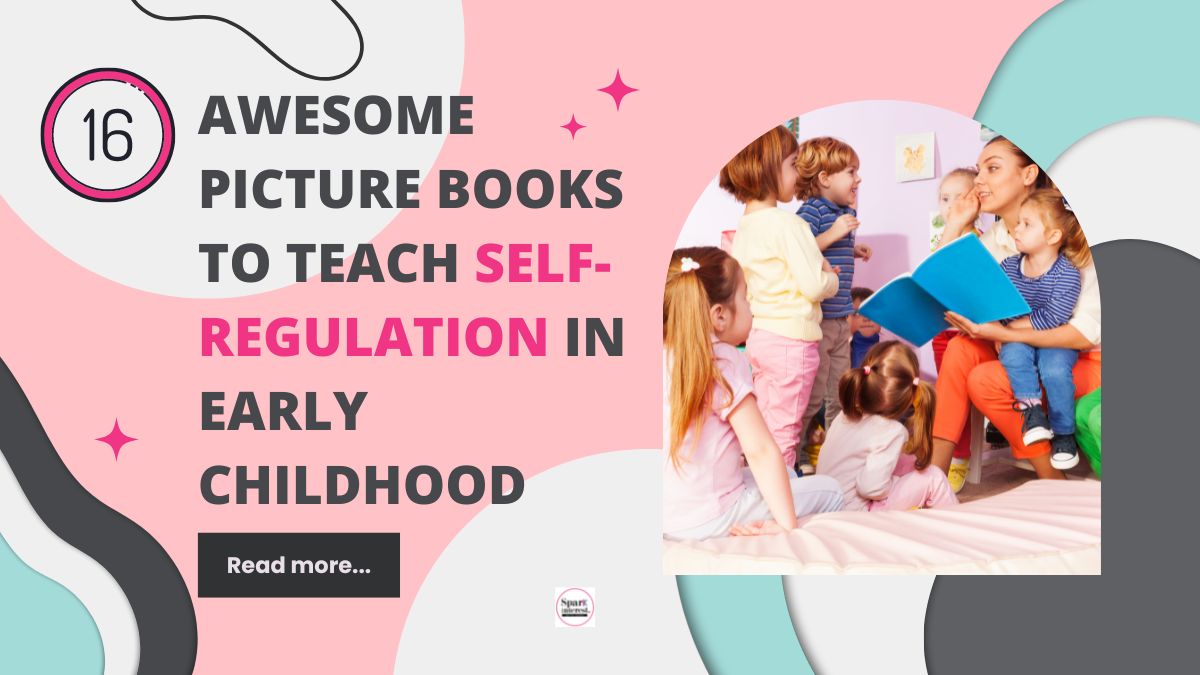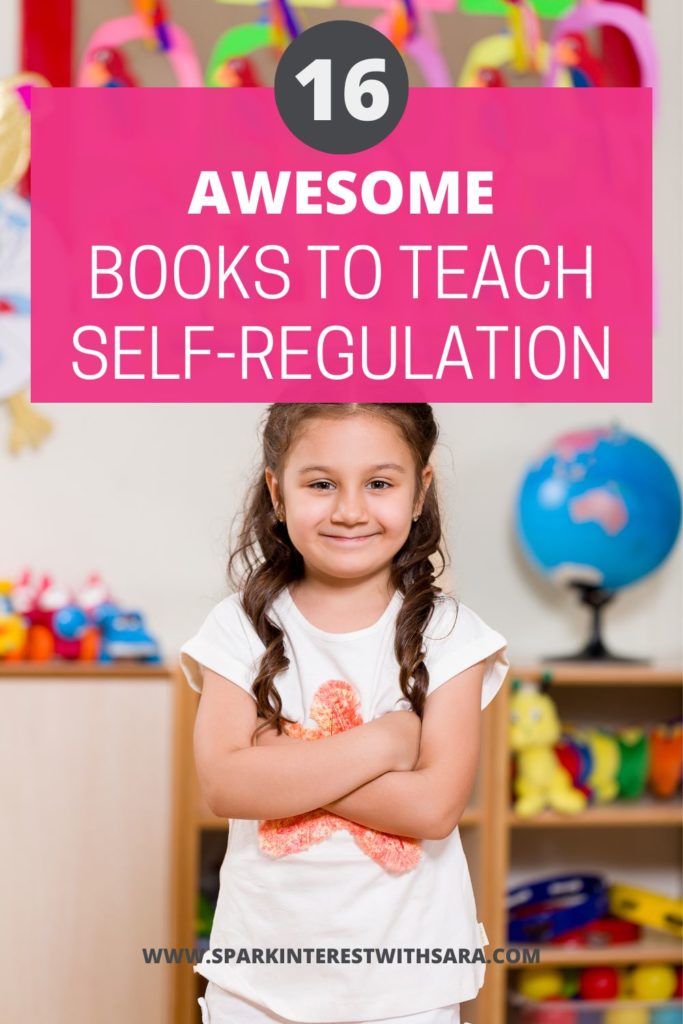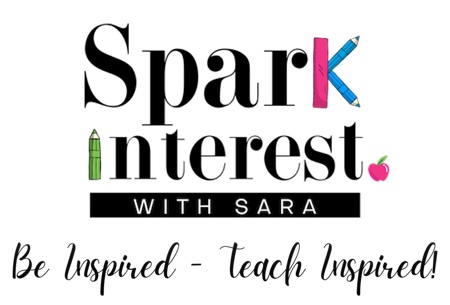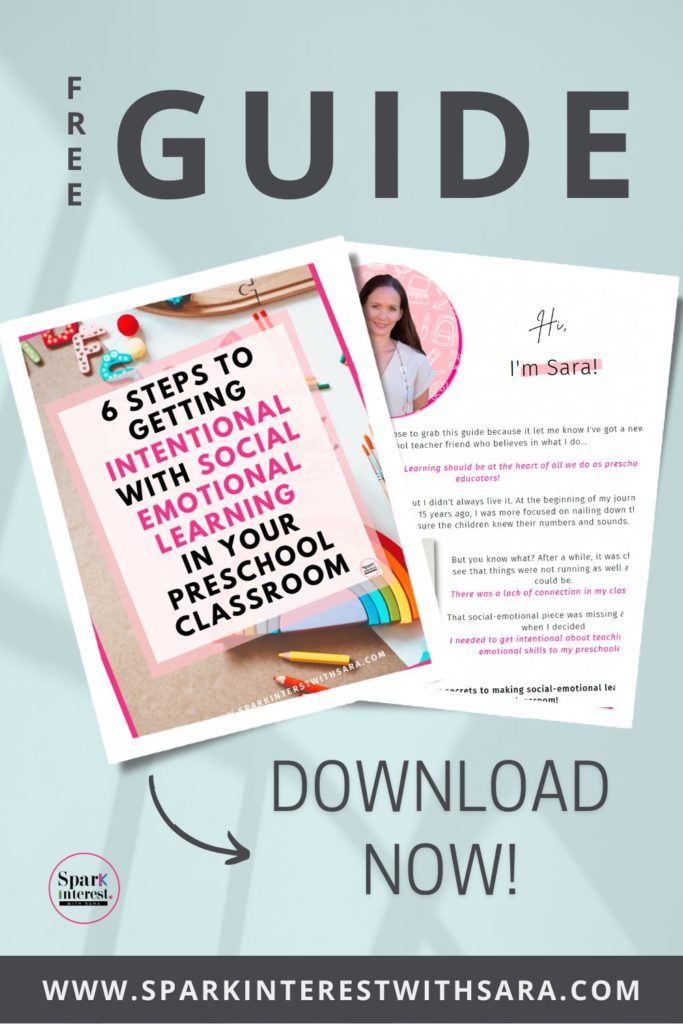
How are your preschoolers doing when it comes to self-regulation? I know. They are only just beginning to learn the skills necessary to regulate them and their abilities will vary greatly within one classroom. If you are reading this blog post you must be seeing that your students need more support in this area. Perhaps you are wondering how you can help your preschoolers even more with self-regulation, cause you know how important it is.
I’m so glad you are here!
The good news is, there are a lot of activities you can implement to help teach your young learners about their strong emotions and self-regulation. Teaching self-regulation in early childhood education is very important, and as preschool teachers, our role is to support our students as they navigate this complex world of emotions.
Before I jump into sharing my favourite books I use to help teach my students about self-regulation, I wanted to share with you my FREE guide to easily planning and incorporating social emotional learning into your preschool program. If you want to make social emotional learning at the heart of your preschool room, and don’t know where to even start, click on the image below to download it!
What Is Self-Regulation?
When children can self-regulate, they can understand and manage their behavior. Being able to understand and manage our behavior means we can react appropriately to our feelings or the things happening around us.
When students are using self-regulation in the classroom, we want our young learners to be able to:
- Know how to calm down when needed.
- Manage and Control impulses.
- Focus on a task or be able to refocus when needed.
- Regulate strong emotions like frustrations, excitement, and anger. Using Mindful exercises can help with self-regulation!

16 Books To Help Teach Self-Regulation In Early Childhood
Self-regulation is a critical skill students need to learn in early childhood development. As preschool teachers, we must take the time to teach, develop, and practice those self-regulation skills. Using books to help model self-regulation examples, discuss what self-regulation is and why self-regulation is important. These 16 books will help you do all that and more!
- Positive Ninja: A Children’s Book About Mindfulness and Managing Negative Emotions and Feelings By Mary Nhin
This is a great new series named Ninja Life Hacks and was developed to help teach kids (and adults) valuable life skills using fun characters!
In this book, full of mindfulness and optimism, a negative ninja turns positive using a simple strategy. A great book full of lessons with a little bit of humor!
- When I’m Feeling Angry By Tracey Moroney
Part of The Feelings Series, this book helps students learn what to do when they are angry.
- A Little SPOT of Emotions 8 Book Box Set By Diane Alber
The perfect book set to start with when discussing emotions and how to regulate them!

Emotions are complicated and challenging to understand and explain. This set of books helps teachers explain all the basic emotions like happiness, sadness, anger, anxiety, love, confidence, peacefulness, and a mix of it all! The box set allows you to look at each emotion and discuss examples of self-regulation your students can use with each one.
- A Little SPOT of Feelings 8 Book Box Set By Diane Alber
This box set builds off the A Little SPOT of Emotions Box Set and gives support to teachers and parents to help them explain more complex feelings like empathy, frustration, calm, belonging, worry, boredom, and flexible thinking. Each book uses a fun feelings detective to discuss each emotion. This box set is a dream tool for the classroom and can help develop essential social and emotional skills through understanding feelings—a great addition to any self-regulation lesson.
- Everyone Feels Angry Sometimes By Daniela Owen
Part of another great series, including sadness and anxiety. Kids learn emotion management skills and learn how to navigate their expressions of feelings.
This specific book discusses how anger can erupt like lava. Everyone Feels Angry Sometimes teaches mindfulness for kids and how to prevent a little spot of anger or a little spot of frustration from growing into a full-blown tantrum. It also teaches the four levels of anger and teaches regulation skills for kids. So they can take action to avoid reaching their breaking point!
- How to Be a Superhero Called Self-Control! By Lauren Brukner and Apsley
Self-control is a superhero who teaches young children all about self-control! Anxiety, frustration, anger, and other emotions don’t stand a chance when students learn about self-control! This book teaches kids about self-massage, deep pressure, breathing exercises, and mindfulness activities like finding a peaceful place. It also includes a lot of teaching tools in the appendix!
- B is for Breathe: The ABCs of Coping with Fussy & Frustrating Feelings By Melissa Munro Boyd
This book covers the letters A-Z and celebrates how children can express their feelings. It also shows the development of coping skills in a simple way even our youngest learners will understand. It discusses feelings, positive behaviors, and different calm-down strategies.
- Find Your Calm: A Mindful Approach To Relieve Anxiety And Grow Your Bravery By Gabi Garcia
Part of the Growing Hearts & Minds picture book series, Find Your Calm is a great book and teaches children how to tap into their sense of safety when their anxiety sends a false alarm. They learn what to do next, and the book shows ways to help them find their calm.
It includes simple grounding activities and coping tools for them to practice.
- My Body Sends a Signal: Helping Kids Recognize Emotions and Express Feelings By Natalia Maguire
This book gives you the resources you need to use clear words, familiar situations, exciting pictures, and hands-on activities. Giving you plenty of ways to help your students learn about emotions and how to regulate them effectively. It also has instructions for teachers and follow-up activities, emotion/feelings cards, color pages, and even information about some short stories to help teach empathy.
- Santiago’s Sadness: Making Room for All Emotions By Gabi Garcia
Another great book in the Growing Hearts & Minds series! Ever since his family moved, Santiago had been sad. He didn’t want to play, smile, or anything. But Santiago soon makes a new friend and begins to understand that making room for all of his feelings is a way of being kind to himself. Children will learn coping skills, and the book includes self-regulation activities that reinforce the story’s message.
- I Can Do That: A Book on Self-Regulation By Kayla J.W. Marnach
Part of the Can-Do series, I Can Do That! It helps children learn self-regulation skills and techniques. The book is extraordinary because it’s told through rhyme and the child’s point of view. The strategies shared to empower the child to learn and practice ways to control their emotions and actions. It also includes discussion questions at the end of the book to help children learn more about self-regulating behavior.
- Even Superheroes Have Bad Days (Superheroes Are Just Like Us) By Shelly Becker
Kids have trouble getting a grip on their emotions, and even young superheroes struggle! This book contains colorful, action-packed illustrations and a rhyming text showing many ways superheroes and children can control their desire to be sad, mad, frustrated, lonely, or afraid.
- Listening to My Body: A guide to helping kids understand the connection between their sensations and feelings so that they can get better at figuring out what they need. By Gabi Garcia
Woah, that’s a title! But, this book is everything and more. Another great one comes from the author of Santiago’s Sadness (see above). An engaging and interactive book that helps kids identify feelings and the physical sensations that go along with them. The foundation of self-regulation. Students will learn sensation vocabulary, and there are even activities throughout the book to reinforce what it is teaching! BONUS: It’s available in SPANISH!
- My Mouth Is A Volcano By Julia Cook
Louis is constantly interrupting and often just can’t keep his thoughts to himself. Other friends start to interrupt Louis as he does to them, and he soon learns how to wait for his time to talk respectfully. This book takes an empathetic approach to a habit many of our preschoolers struggle with (interruptions) and teaches a fun technique to help manage them.
- The Way I Act By Steve Metzger
This book discusses 13 different ways of behaving. It is written in verse and has some beautiful illustrations that show positive ideas and how to act in many situations. There is also a companion book called The Way I Feel. In this book, children learned that feelings come and go and simply are.
- Percy Gets Upset By Stuart J Murphy
Percy gets upset. He’ll frown and stamp his feet. But when Percy takes a deep breath, counts to 10, and talks about his feelings, he realizes he can quickly calm down. This is another great series of books that focus on emotions and self-regulation. There are 16 books in the I SEE I LEARN collection.
Teaching Self-Regulation In Early Childhood
When we use the right resources, language, attention, and care to help teach self-regulation to our students, we are developing and teaching our preschoolers to become level-headed and empathetic big kids! Bringing books into your lessons will allow our students to see emotions in different situations and environments and promote meaningful dialogue in response to them.
???? If you are looking for tips on how to actually bring self-regulation instruction into your classroom and help your students, I bet you would love my other blog posts ????????
- 8 Ways to Help Preschoolers Identify Emotions and Regulate Them
- How to help Preschoolers with Self-Regulation and 5 Teacher Approved Tips
- 5 Reasons Why Teaching Preschoolers to Identify Emotions is so Important
Let's Connect:

Sara

